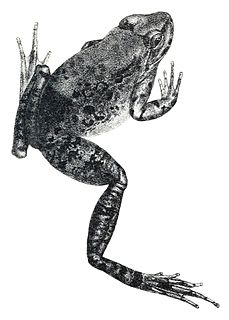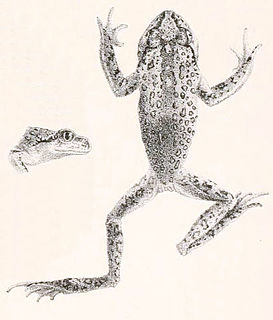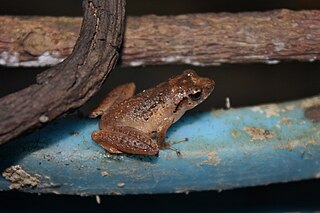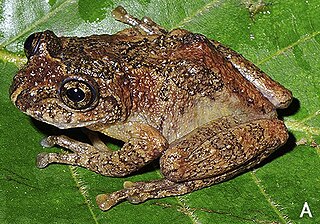
Salamandridae is a family of salamanders consisting of true salamanders and newts. Salamandrids are distinguished from other salamanders by the lack of rib or costal grooves along the sides of their bodies and by their rough skin. Their skin is very granular because of the number of poison glands. They also lack nasolabial grooves. Most species of Salamandridae have moveable eyelids but lack lacrimal glands.

The Rhacophoridae are a family of frogs that occur in tropical sub-Saharan Africa, South India and Sri Lanka, Japan, northeastern India to eastern China, south through the Philippines and Greater Sundas, and Sulawesi. They are commonly known as shrub frogs, or more ambiguously as "moss frogs" or "bush frogs". Some Rhacophoridae are called "tree frogs". Among the most spectacular members of this family are numerous "flying frogs".

Leptobrachella is a genus of frogs in the family Megophryidae. Members of Leptobrachella are found throughout Asia including on Borneo and the Natuna Islands. They are sometimes referred to as Borneo frogs, slender-armed frogs, or dwarf litter frogs. The genus contains over 80 species with 25 found in China alone.

The Rhacophorinae are a subfamily of frogs in the family Rhacophoridae. They range from tropical Africa and Asia to temperate China and Japan.

Kurixalus is a genus of frogs in the family Rhacophoridae. The taxonomy of small rhacophids is difficult and has been subject to many revisions, but molecular genetic data do support monophyly of Kurixalus. These frogs are distributed from Himalayan front ranges of eastern India southward and eastward to Cambodia, Vietnam, southern China, Taiwan, and the Ryukyu Islands.

Amolops is a genus of true frogs native mainly to eastern and south-eastern Asia. These frogs are closely related to such genera as Huia, Meristogenys, Odorrana, Pelophylax and Rana, but still form a distinct lineage among the core radiation of true frogs. They are commonly known as "torrent frogs" after their favorite habitat - small rapid-flowing mountain and hill streams - but this name is used for many similar-looking frogs regardless of whether they are loosely related.

Nanorana is a genus of dicroglossid frogs. They are found in Asia, from the Himalayan region of northern Pakistan and northern India, Nepal, and western China east to montane southern China and southeast to Myanmar, Thailand, Laos, and northern Vietnam. Common names of these frogs reflect the complex taxonomic history of the genus and include Yunnan slow frogs and High Himalaya frogs.

Leptolalax is a genus of frogs in the family Megophryidae. They are sometimes known as Asian toads, metacarpal-tubercled toads, or slender litter frogs, although many species-specific common names do not follow these conventions, and many species do not have common names. They are widely distributed in southeastern and eastern Asia, from southern China and northeastern India to the Malay Peninsula and Borneo. Leptolalax are typically small and have a cryptic colour pattern and no obvious morphological characters useful in systematic studies. Consequently, both molecular genetic analyses and analysis of advertisement calls by male frogs have been important in identifying new species.

Paramesotriton, also known as warty newts or Asian warty newts, is a genus of salamanders in the family Salamandridae. The genus is found in southwestern and southern China and in northern Vietnam. Most of the species are endemic to China, and the majority of them have been described recently, since 2008. The genus includes both pond and stream dwellers.

Scutiger is a genus of toads in the family Megophryidae. Common name lazy toads has been coined for them. They occur in China, Burma, Nepal, and northern India in high-altitude habitats. Most are endemic to China.

Xenophrys is a genus of amphibians in the family Megophryidae. They are found in southeastern Asia to Borneo. Their common name is strange-horned toads.
Liurana alpina is a species of frog in the family Ceratobatrachidae. It is endemic to China and only known from its type locality, Dayandong in Mêdog County, Tibet. This little known species lives under moss in forest at about 3,100 m (10,200 ft) asl.
Liurana xizangensis is a species of frog in the family Ceratobatrachidae. It is endemic to Tibet, China, and only known from the region of its type locality, Yi'ong, in Bomê County. It is also known as Xizang eastern frog and Xizang papillae-tongued frog.

The Ceratobatrachidae are a family of frogs found in the Malay Peninsula, Borneo, the Philippines, Palau, Fiji, New Guinea, and the Admiralty, Bismarck, and Solomon Islands.

Romerus is a small genus of rhacophorid frogs that are distributed in southern China. Some species now in Romerus were originally placed in Philautus. It is thought to be the most basal genus in the Rhacophorinae.
Zhao Ermi was a Chinese herpetologist, born in Chengdu. His ancestors were Manchu Bannerman of Irgen Gioro clan who were stationed in Chengdu during Qing Dynasty. He was elected a member of the Chinese Academy of Sciences in 2001. He died at West China Medical Center of Sichuan University on 24 December 2016.

Nasutixalus is a genus of frogs in the family Rhacophoridae. The genus is found in northeastern India and adjacent southeastern Tibet as well as western Yunnan (China); the range might extend into the adjacent Nepal and Myanmar. Common name ridged-nose treefrogs has been coined for this genus.

Diploderma is a genus of lizards in the family Agamidae. Species of Diploderma are native to Myanmar, China, Vietnam, Taiwan, and Japan. Most of the species are found in China, including many endemics.

Boulenophrys is a genus of frogs in the family Megophryidae. They occur in the China, Mainland Southeast Asia and Northeast India. It had been placed variously as a subgenus or synonymy of Megophrys. Dubois, Ohler and Pyron first recognized that Panophrys is proccupied and employed Boulenophrys as the generic name rather than Tianophrys under the Principle of First Revisor.

Nidirana is a genus of true frogs (Ranidae) from East and Southeast Asia. They are commonly known as music frogs. This genus contains numerous species that were formerly classified in the genus Babina, which is thought to be its sister genus.
















